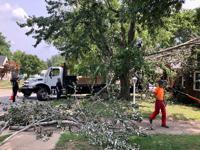It can be staggering — every spring, just before the trees begin to bud, city workers show up and mark old trees with a white ring to indicate they’re about to be felled.
Local residents panic, often surprised, and start talking about the impact the loss of these trees will have on their neighborhoods and the environment.
Each year, hundreds of trees pass to make way for infrastructure projects, from road remodeling to sewer repairs. Why do so many trees fall over in the forest town of all places?
CBC News spoke to Jennie Dann, the city’s director of construction and infrastructure services, to find out.
Jennie Dann is London’s Director of Works and Infrastructure Services. (provided by the City of London)
CBC: Why do certain construction projects require some trees to be removed?
JD: There are a number of reasons. We conduct an assessment of all trees. We look for trees that already have health problems and need to be cut down for safety reasons.
Sometimes we widen roads and some of the work we do is underground. On the surface it may not appear that these trees will be affected by the road works, but if we need to fix underground sewers and water pipes, the digging work we need to do can affect the root zone. If the tree wouldn’t survive anymore, then we have to cut down the tree.
 A graphic shows how much larger the root system is than visible above ground. (provided by the City of London)
A graphic shows how much larger the root system is than visible above ground. (provided by the City of London)
CBC: Are there any alternatives to remove?
JD: We use various techniques such as hand digging and trenchless technologies for underground repairs to avoid impacting trees, but sometimes this is unavoidable. We’re trying to make sure we have a really clear plan on how to protect the unaffected trees and how we’re going to replace the affected trees.
Digging with the ditch can be very effective for the trees. There may be situations where we had planned digging and once we get a lot of feedback we will look at additional ways to use this as a technique. On a recent project we use a trench box which allows us to have a thinner trench when excavating the underground infrastructure. Sometimes we get too far into the root zone and that’s where we really need to look for replanting options.
CBC: When can these methods be used?
JD: It’s really a case-by-case decision. We’re looking at if, if we’re just entering the root zone of a tree, we can use some of these alternative techniques to stay out of that root zone and prevent damaging the tree’s root structure.
Many people may not realize that if you look at a large tree and follow the line down from the tops of the branches, this is actually the tree’s drip line, where the main root system is located. In addition, there are also small feeding roots. With a lot of these trees, you really have to consider what’s happening underground.
 A graphic showing the root systems of trees. (provided by the City of London)
A graphic showing the root systems of trees. (provided by the City of London)
CBC: What building projects are underway in London that are removing trees?
JD: It’s really important that we keep improving our infrastructure, which includes both our roads and our underground infrastructure, to support the growth of the city. When it reaches the end of its life we go in and try to revitalize those streets and that can often impact trees. We’re working hard to mitigate this by changing our designs to streamline things and limit our impact.
CBC: How many trees are planned to be removed this year so far?
JD: In 2022, a total of 579 trees were removed and 8,874 trees were planted by the city (4,250 of which were on streets, the rest in parks.
In 2021, 410 trees were removed and 8,500 trees planted by the city. 5,294 of these were on streets, with the rest in parks.
We don’t have the 2023 totals yet, but it will be similar to last year.
CBC: What are the risks if these trees are not removed?
JD: If we invade the root zone and damage it due to our underground infrastructure work, the tree may begin to fail. Because it doesn’t have the root structure to support it, there are safety concerns about the trees tipping over.
CBC: The city aims to increase tree canopy coverage to 34% by 2065. How do these infrastructure projects affect this goal?
JD: For most of our infrastructure projects, we do our best to try to replace trees to the point of removing them. And if not, we look for other places nearby where we can find planting opportunities.
On many of our larger projects like the rapid transit where we widen roads, there may not be quite the same space or real estate to place one-to-one trees for losses. So we actually planted in other areas along nearby streets and parks so we continue to balance and grow our street canopy in the city.
The interview has been edited for length and clarity.
CBC: What is your message to Londoners who are concerned about the loss of trees in their neighborhoods and the impact it is having on the environment?
JD: I think moving forward it’s really important that we take care of our aging infrastructure and that we look at these roads as we rebuild them to revitalize them with a holistic approach. Our landscaping strategy is an integral part of this. When we impact existing trees we want to make sure we are providing Londoners with quality replacement trees so they can grow into a great street for generations to come.
www.cbc.ca
https://www.cbc.ca/news/canada/london/q-a-why-is-london-cutting-down-so-many-trees-for-construction-a-city-staffer-explains-1.6809149













